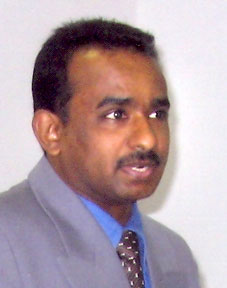|
| |
Tips on Public Speaking
Toastmaster
| Public Speaking |
Impromptu Speech |
Ice Breaking ( first) Speech|
Evaluation
What
is success ?|
Success
secrets
|
How
to be happy |
Memory
techniques |
IAS Topper
| Sermons
| Time
Management |
How to stop ageing
| How
to sleep well | more......

Tips on Public speaking & Communication - by Dr. Binu James Mathew, PhD (IIT Bombay)
There are fundamentally two types of speeches
one is a cassock-like speech, which extends the whole area, but doesn’t touch
any important parts.
The second one is a bikini speech – which touches just the important parts,
nothing more than that, but leaves the audience with a lot of imagination!
So, this shows how important it is to prepare your speeches.
As you know, there are various methods of speech delivery – viz.,
the manuscript delivery,
memorized delivery,
impromptu delivery and
extemporaneous delivery
There are four steps towards a successful speech: let’s call it 4 Ps
1. Plan
2. Prepare
3. Practice
4. Present
Many of us do not feel like leaving our comfort zone, that’s to be a part of the
faceless crowd. Many among us will have butterflies in our stomach – the stage
fright – when we think of giving a speech or a presentation in front of an
audience. You feel like something is fluttering inside you. But if you analyse
the root cause behind the nervousness, you will find that they are basically due
to two reasons:
1. Fear of judgment and
2. Lack of adequate preparation
Of course, none of us likes being judged, but we can’t control every thought
people have about us. But we can influence favourable responses by careful
planning.
Practice, Practice, Practice is your key to confidence. More preparation
increases chances of success
Have you ever stirred into action because the speaker was so exited about the
message?
Enthusiastic deliveries promote enthusiastic responses
Looking relaxed is one of speaker’s most difficult challenges.
Decide what you want to say and to whom you want to say
Distinct beginning, middle and end for your speech
Talk about what your audience wants to hear, not want you want to say
Remember: you and your listeners need each other
Audience – not an adversary
They want to know what you say
Potential for great chemistry! Activate it!
Style is what distinguishes you from everyone else
We are always communicating in two languages – vocal and body languages
Facial expressions
Mirror practice and video taping
Body language speaks louder than words
Posture
Standing – distributing the weight of the body into both legs
Walking with firm footsteps to podium, standing at ease, 45 degree angle
Chest up and stomach in
Poise & Confidence
Eye Contact
Looking into one pair of eyes, pause for a few seconds, and move to another
pair
Gesture
paint mental images
Facial Expressions
No blank-slate
Eyes, lips, eyebrows, all are animated, conveying the message
Pronunciation & Accent
Voice Modulations
Speed/Pace of Speech Vs. Thought speed
Be natural, 120-150 words per minute
Volume – enough for everyone in the audience
Have something to say
Speak with passion
Put yourself into your speech
Respect yourself
Respect your audience
Respect words
Keep to time limits
Humour – lighter side, but not at the expense of someone/group
Smile – the universal gesture of goodwill
Fact:
o 93% of all communication is conveyed in ways other than words
o Tone of voice: 38%
o Body language, face & appearance: 55%
o Words: 7%
To conclude, remember
It is almost impossible to succeed if you cannot communicate effectively
To put it positively, if you are able to make powerful presentations, your
chances for career success will increase tremendously.
“Never let them see you sweat”
With a little bit of humour and some unabashed warm-ups and a good practise, you
can take advantage of the opportunity of oral presentations and transform your
personal and professional personae.
( Dr. Binu James Mathew, PhD
joined the College of Banking and Financial Studies (CBFS), Muscat, Sultanate of
Oman, in 2004 as a Lecturer (EFL/ESL) at the English Language Centre. Presently,
he undertake additional responsibilities such as designing and conducting
Executive Training Programmes for CBFS and Coordinating CBFS Committees.
Previously, he gained valuable academic and research experience working as a
Lecturer in colleges affiliated to the University of Mumbai for 9 years, and as
a Research Scholar in the Indian Institute of Technology (IIT Bombay) from where
he obtained his doctoral degree. He was also a part-time faculty member of the
Institute of Management Studies (IMS India), Mumbai. In addition, he served
part-time as a Sub-Lieutenant and Divisional Commander of Indian Navy’s NCC
Unit, Ministry of Defense, in Mumbai, and have undergone naval training and
activities, which is provisional under University Acts in India. In 2002,
he obtained his Doctor of Philosophy (Ph.D.) from India’s premier institute, IIT
Bombay after completing M.Phil. (English) in 1995, M.A. (English) in 1994, and
B.A. (English) in 1992. Besides English Language Teaching (ELT), his areas of
interests are: Business Communication, Computers and Networking, CALL, and
Phonetics. He has published and presented research papers in books &
international conferences, compiled & edited academic material, and have been
designing & conducting corporate/executive training programmes on Business
Communication, Presentation & Interpersonal Skills, The Art of Presenting
Information Reports and Communicative Skills in English. He can be contacted at
binujamesmathew@gmail.com ,
http://sites.google.com/site/binujamesmathew/ )
| |
|



